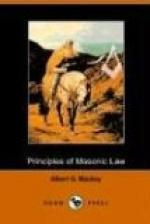The “lex scripta,” or written law of Masonry, is derived from a variety of sources, and was framed at different periods. The following documents I deem of sufficient authority to substantiate any principle, or to determine any disputed question in masonic law.
1. The “Ancient Masonic charges, from a manuscript of the Lodge of Antiquity,” and said to have been written in the reign of James II.[1]
2. The regulations adopted at the General Assembly held in 1663, of which the Earl of St. Albans was Grand Master.[2]
3. The interrogatories propounded to the Master of a lodge at the time of his installation, and which, from their universal adoption, without alteration, by the whole fraternity, are undoubtedly to be considered as a part of the fundamental law of Masonry.
4. “The Charges of a Freemason, extracted from the Ancient Records of Lodges beyond sea, and of those in England, Scotland, and Ireland, for the use of the Lodges in London,” printed in the first edition of the Book of Constitutions, and to be found from p. 49 to p. 56 of that work.[3]
5. The thirty-nine “General Regulations,” adopted “at the annual assembly and feast held at Stationers’ hall on St. John the Baptist’s day, 1721,” and which were published in the first edition of the Book of Constitutions, p. 58 to p.
6. The subsequent regulations adopted at various annual communications by the Grand Lodge of England, up to the year 1769, and published in different editions of the Book of Constitutions. These, although not of such paramount importance and universal acceptation as the Old Charges and the Thirty-nine Regulations, are, nevertheless, of great value as the means of settling many disputed questions, by showing what was the law and usage of the fraternity at the times in which they were adopted.
Soon after the publication of the edition of 1769 of the Book of Constitutions, the Grand Lodges of America began to separate from their English parent and to organize independent jurisdictions. From that period, the regulations adopted by the Grand Lodge of England ceased to have any binding efficacy over the craft in this country, while the laws passed by the American Grand Lodges lost the character of general regulations, and were invested only with local authority in their several jurisdictions.
Before concluding this introductory section, it may be deemed necessary that something should be said of the “Ancient Landmarks of the Order,” to which reference is so often made.
Various definitions have been given of the landmarks. Some suppose them to be constituted of all the rules and regulations which were in existence anterior to the revival of Masonry in 1717, and which were confirmed and adopted by the Grand Lodge of England at that time. Others, more stringent in their definition, restrict them to the modes of recognition in use among the fraternity. I am disposed to adopt a middle




